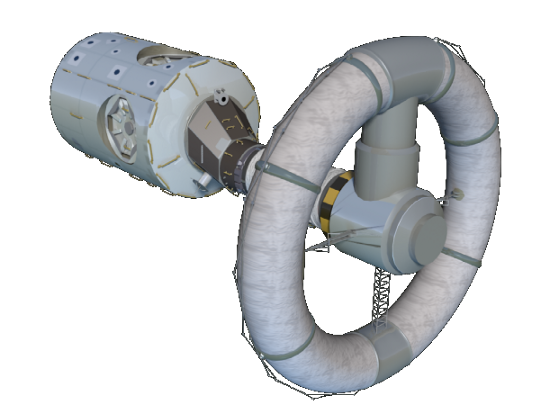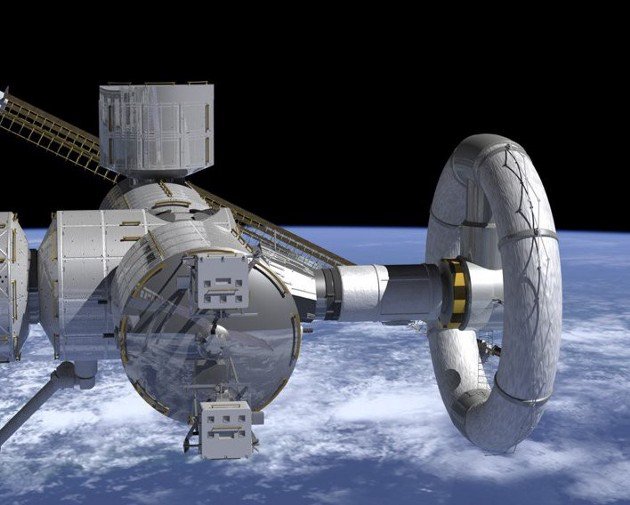Nautilus-X, NASA’s Cancelled Interplanetary Shuttle
One of the most tiresomely common questions I’ve seen astronauts field during live streams from the ISS, usually to school children is “where does your poop go?” That’s not what this article is about however. The second most common question is “Why doesn’t NASA just put engines on the ISS so you can fly it to other planets in the solar system?”
The answer to the first question is that astronaut waste is first compacted into dense pellets, then fired from a cannon down to the streets of Portland where it won’t make any difference to the locals. The answer to the second question is that the ISS was designed as a space station from the start, which entailed certain compromises.
The design considerations for a space habitat that will never leave LEO are very different from those of a vehicle that needs to be able to break orbit and survive the interplanetary environment. For example the ISS is in sufficiently low an orbit that it’s still within Earth’s magnetosphere, protecting it from radiation.
The docking seals and module mounting points were also not designed to survive the structural stresses of boosting it out of Earth orbit, which would’ve required a laundry list of compromises elsewhere in the ISS design reference study.
That’s not to say NASA couldn’t use the same on-orbit multi-module construction methodology as the ISS to build a large interplanetary spacecraft. Much larger than anything we could lift all at once out of Earth’s gravity well, ala the space shuttle.
This would furnish astronauts with much less cramped conditions for long space journeys than the Orion capsule, even with a habitation module attached. It would be safer too. A craft that size could hold a significant surplus of essentials like food, water and oxygen, safeguarding against Apollo 13 style disasters.
This is such a good idea, in fact, that NASA already thought of it. They called it the Nautilus-X, named after the first nuclear powered submarine. Essentially it was to be a small space station similar to the Lunar Gateway but mobile, with inflatable habitation modules, a spin-gravity ring section just large enough for the crew to sleep in, a lunar lander garage, and a VASIMR engine to propel the whole mess around the solar system.
The smaller configuration is shown above. Being modular like the ISS, Nautilus-X could be added to or subtracted from depending on what each mission required. The VASIMR engine (Variable Specific Impulse Magnetoplasma Rocket) works similarly to an ion engine except that it carries its own propellant, which is excited into a plasma before being electromagnetically accelerated out the rear of the engine.
A 20 megawatt VASIMR engine would permit an unprecedented travel time of 39 days from Earth to Mars, including the acceleration and deceleration burns. This would absolutely require the use of a compact nuclear reactor launched from Earth however, which would come with a suite of political complications.
The inflatable modules would make Nautilus-X among the most comfortably roomy space vehicles in history, second only to Skylab. Now defunct, Bigelow once planned individual inflatable modules which by themselves had nearly the same interior volume as the entire ISS. That’s one module, a single launch.
Now with Bigelow out of the private spaceflight game, Sierra Nevada carries the inflatable habitat torch. Sadly they were passed over as a potential supplier for Lunar Gateway in favor of Northrup Grumman, who opted for a traditional tin can style of module instead of Sierra Nevada’s inflatable module proposal.
The largest configuration of Nautilus would’ve had ten such modules, most of which would be dedicated to storing food and equipment. But the most visibly distinct feature of the Nautilus-X has got to be the spin gravity ring section. Itself an inflatable, the spin gravity ring isn’t even large enough in diameter to stand up inside of.
It would strictly be for sleeping. Crew would climb into it, take their horizontal positions (relative to the axis of rotation, which is “up” in this scenario) and enjoy fractional gravity for the duration of their slumber. Full Earth gravity would require spinning the ring uncomfortably fast.
Therein lies a big problem with centrifuges, they need to be quite large before you can spin them fast enough to match Earth gravity without making the occupants blow chunks. Still, fractional gravity for 5–8 hours each “night” is better than spending the entire mission in microgravity.
It’s believed this would function as a sort of band-aid on the gaping wound of all the various physiological ailments caused by prolonged exposure to microgravity. Similar to how even a few minutes of walking per day, while it won’t make you ripped, is clinically shown to result in markedly better health outcomes later in life.
To find out exactly how much benefit the spin gravity sleeping ring could offer to astronauts on long duration interplanetary voyages, a demonstrator module was planned for attachment to the ISS. However since Nautilus-X never progressed beyond a design reference study, neither did this demonstrator module.
That’s perhaps the biggest loss in all of this. To date, no space vehicle or habitat has ever had artificial gravity except for a brief experiment in spinning two spacecraft attached by tether, during Gemini XI in 1966. Spin gravity via centrifuge has never been done, so it remains a question mark exactly how effective it would be at slowing down microgravity inflicted deterioration of bone and muscle mass.
VASIMR is likely to get used eventually. The last official commentary on its applications I can find suggests its first use will be sending unmanned resupply vessels to Lunar Gateway in support of the planned Lunar surface habitat. Eventually VASIMR may also carry unmanned supply landers to Mars, in support of colonization efforts. Vehicles that will never carry human passengers, of course, will have no need of artificial gravity.
Nautilus-X is very likely an obsolete design in the age of Starship. But for all its roomy splendor, Starship also won’t have a centrifuge. Conceivably you could link two starships nose to nose with a tether and spin them around like bolos on their way to Mars, an approach made famous by the recent sci-fi film Stowaway.
If VASIMR needs nuclear material onboard anyway, it also may turn out to be the case that nuclear rockets (ala NERVA) make more sense for manned vehicles. Certainly DARPA seems to think so, having recently awarded a contract for nuclear rockets to Blue Origin.
A nuclear propelled Starship lifted by a chemical booster would have most, if not all the advantages of Nautilus-X. In particular if the tethered bolo approach were used to generate spin gravity for the occupants. Such a configuration would in fact be superior in most respects while requiring drastically fewer launches.
Still, the Nautilus-X is a heart-breakingly beautiful craft, and would’ve been the logical next step after the ISS if not for SpaceX. In another timeline, rather than the dull samey live reports we often get from the ISS, we might instead see (delayed) live feeds of the Nautilus-X crew reporting to us from Mars orbit. Or Venus. Or Saturn, Neptune, or Jupiter.
Farewell Nautilus-X, the Enterprise that never was. Disappear into history, fading from the public consciousness, but not from our hearts. Never to fly among the stars, but instead to fo
rever fly through the impossible realms of imagination and dreams.




